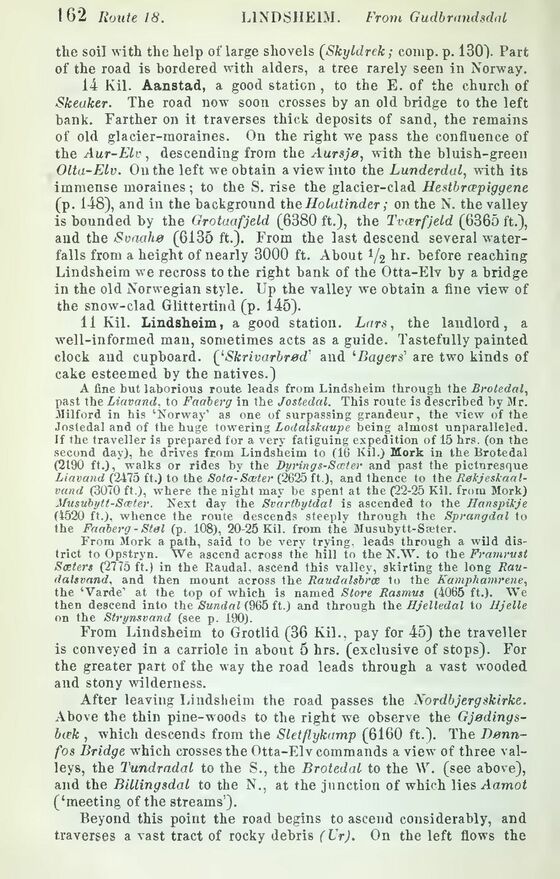
Full resolution (JPEG) - On this page / på denna sida - Norway - Pages ...

<< prev. page << föreg. sida << >> nästa sida >> next page >>
Below is the raw OCR text
from the above scanned image.
Do you see an error? Proofread the page now!
Här nedan syns maskintolkade texten från faksimilbilden ovan.
Ser du något fel? Korrekturläs sidan nu!
This page has never been proofread. / Denna sida har aldrig korrekturlästs.
the soil with the help of large shovels (Skyldrek; comp. p. 130). Part
of the road is bordered with alders, a tree rarely seen in Norway.
14 Kil. Aanstad, a good station , to the E. of the church of
Skeuker. The road now soon crosses by an old bridge to the left
bank. Farther on it traverses thick deposits of sand, the remains
of old glacier-moraines. On the right we pass the confluence of
the Aur-Elv, descending from the Aursjø, with the bluish-green
Olta-Elv. On the left we obtain a view into the Lunderdal, with its
immense moraines; to the S. rise the glacier-clad Hestbrcepiggene
(p. 148), and in the background theHolatinder; on the N. the valley
is bounded by the Grotuafjeld (6380 ft.), the Tvarfjeld (6365 ft.),
and the Svaahø (6135 ft.). From the last descend several
waterfalls from a height of nearly 3000 ft. About V2 hr. before reaching
Lindsheim we recross to the right bank of the Otta-Elv by a bridge
in the old Norwegian style. Up the valley we obtain a fine view of
the snow-clad Glittertind (p. 145).
11 Kil. Lindsheim, a good station. Lars, the landlord, a
well-informed man, sometimes acts as a guide. Tastefully painted
clock and cupboard. (‘Skrivarbrød’ and ‘Bagers’ are two kinds of
cake esteemed by the natives.)
A fine but laborious route leads from Lindsheim through the Brotedal,
past the Liavand, to Faaberg in the Jostedal. This route is described by Mr.
Milford in his ‘Norway’ as one of surpassing grandeur, the view of the
Jostedal and of the huge towering Lodalskaupe being almost unparalleled.
If the traveller is prepared for a very fatiguing expedition of 15 hrs. (on the
second day), he drives from Lindsheim to (16 Kil.) Mork in the Brotedal
(2190 ft.), walks or rides by the Dyrings-Sæter and past the picturesque
Liavand (2475 ft.) to the Sota-Sæter (2625 ft.), and thence to the
Rekjeskaal-vand (3070 ft.), where the night may he spent at the (22-25 Kil. from Mork)
ifusubytt-Saeter. Kext day the Svartbytdal is ascended to the Hanspikje
(4520 ft.), whence the route descends steeply through the Sprangdal to
the Faaberg-Stel (p. 108), 20-25 Kil. from thé Musubytt-Sæter.
From Mork a path, said to he very trying, leads through a wild
district to Opstryn. We ascend across the hill to the N.W. to the Framrust
Saiters (2775 ft.) in the Raudal, ascend this valley, skirting the long
Rau-dalsvand, and then mount across the Raudalsbrce to the Kamphamrene,
the ‘Varde’ at the tup of which is named Store Rasmus (4065 ft.). We
then descend into the Sundal (965 ft.) and through the Hjelledal to lljelle
on the Strynsvand (see p. 190).
From Lindsheim to Grotlid (36 Kil., pay for 45) the traveller
is conveyed in a carriole in about 5 hrs. (exclusive of stops). For
the greater part of the way the road leads through a vast wooded
and stony wilderness.
After leaving Lindsheim the road passes the Nordbjergskirke.
Above the thin pine-woods to the right we observe the
Gjødings-bæk , which descends from the Sletflykamp (6160 ft.). The
Dønn-fos Bridge which crosses the Otta-Elv commands a view of three
valleys, the Tundradal to the S., the Brotedal to the W. (see above),
and the Billingsdal to the N., at the junction of which lies Aamot
(‘meeting of the streams’).
Beyond this point the road begins to ascend considerably, and
traverses a vast tract of rocky debris (Ur). On the left flows the
<< prev. page << föreg. sida << >> nästa sida >> next page >>